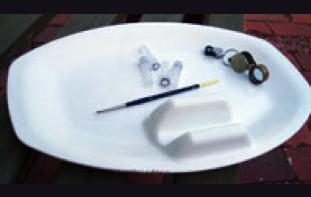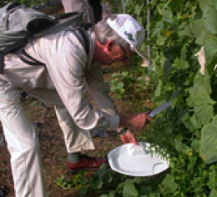中国蓟马科分属检索表及各属简介
蓟马的采集和标本制作
See also: Zhang H-G, Okajima S & Mound LA (2006) Collecting and slide preparation methods of thrips. Chinese Bulletin of Entomology 43: 725-728.
Thrips species usually cannot be recognized without mounting specimens onto microscope slides. Slide preparation techniques are best considered under two headings:
But the quality and value of slide mounts is largely dependent on the care with which specimens are collected and preserved.
Collecting
Thrips may be collected into a fluid known as AGA, a mixture of 10 parts of 60% ethanol with 1 part of glycerine and 1 part of acetic acid. This mixture helps to distend the body of most thrips and keeps the body parts supple. Alternatively, the thrips may be collected into 80-95% ethanol, and provided that they are subsequently stored in a freezer may still yield reasonable quality microscope slides. Specimens preserved this way are particularly useful for DNA studies.

equipment

beating technique
Thrips may be beaten from flowers, leaves and dead twigs. A small but heavy garden trowel is a convenient beating implement. The most convenient beating tray for thrips is a plastic Australian Party tray with a finger grip at the side. The feet of thrips adhere to the plastic surface, and the thrips can be picked off with a small brush or grass stem into the collecting fluid in tubes.
The best tubes for field use are plastic Ependorf Tubes, as used in molecular biology laboratories for centrifuging, because these have screw tops that include a sealing ring, and neither leak nor break. Ensure that each tube contains a label, either printed or written in pencil.
Specimens stored in alcohol should be kept in the dark, preferably at temperatures well below 0°C, to prevent loss of colour.